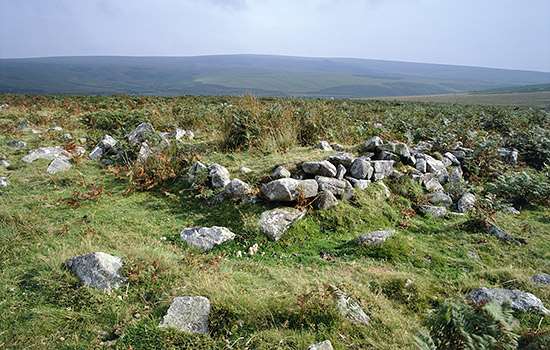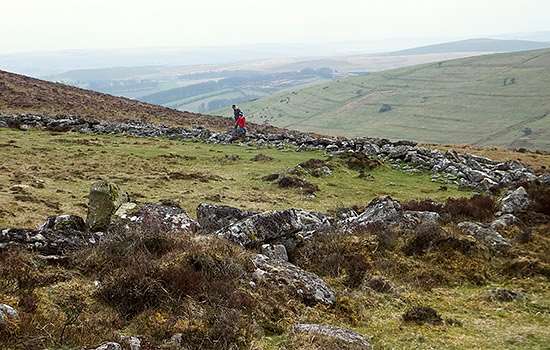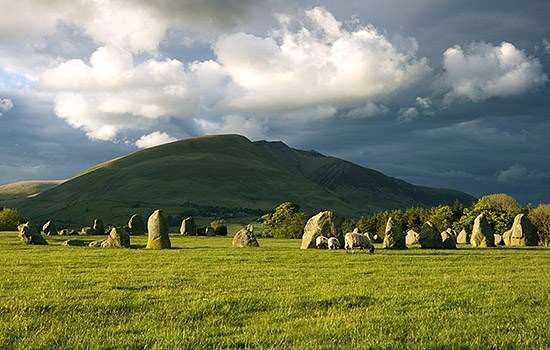Today the Upper Plym Valley is a typically treeless Dartmoor landscape, grazed by cattle, sheep and ponies. It is hard to imagine it 3,500 years ago, during the Bronze Age, when it was dotted with settlements of neat roundhouses, with fields of crops growing near the river and herds of pasturing animals on the higher slopes. In medieval and later times, too, it was alive with the activity of rabbit farming and tin streaming. Some indication of the level of activity that once took place here was provided by an archaeological field survey undertaken between 2001 and 2002, when more than 300 monuments dating chiefly from these two periods were recorded.
The area extends from the source of the river Plym down to the china clay pits at Lee Moor, a distance of some 4.5 miles.
Bronze Age settlement
There are especially well-preserved concentrations of Bronze Age settlements and enclosures on Trowlesworthy, Willings Walls and Hentor warrens. The enclosures consist of low, fragmentary walls made of large boulders, while the settlements consist of roundhouses, with small terraces in the hillsides enclosed by low rubble or slab walls.
Some of the most distinctive Bronze Age remains on Dartmoor are the low, stony, earth-covered banks known as reaves. Made up of granite boulders and layers of turf, these were boundaries that demarcated zones of territory or shared pasture, and can be seen running for miles across the moorland. Over 125 miles of reaves have been identified on the moor. A good example in the Upper Plym Valley is Trowlesworthy Reave, which crosses the moor on the hillside below Shell Top. Elsewhere on the moor and on its fringes, many field boundaries in use today still follow the line of ancient reaves.
Funerary and ritual monuments
There are also many funerary monuments in the Upper Plym Valley, represented by small, roughly circular cairns or mounds of stone. The best-preserved examples contain box-like burial chambers made of granite slabs, and have retaining circles of upright slabs around them.
On the gentle slope mile south of Great Trowlesworthy Tor are two stone rows. One of these has a small stone circle of eight stones at its northern end. Dartmoor has a greater concentration of surviving stone rows than anywhere else in Britain, but their purpose largely remains an enigma. They date from the late Neolithic (3000–2300 BC) but probably continued in use for centuries after. Together with stone circles and some of the more elaborate funerary monuments, they form what must have been significant ritual areas, possibly the scenes of religious ceremonies.
Medieval Farming
There is a notable absence in the Upper Plym Valley, as elsewhere on Dartmoor, of remains from the Iron Age and Roman periods. Environmental evidence has shown that the farmers of the Neolithic and Bronze Age cleared the woodland on Dartmoor, degrading the soil and creating moorland. By the end of the Bronze Age, it was not economic for farmers to live on Dartmoor’s fringes and the land became only seasonal pasture.
There is much evidence of occupation and activity in the medieval period, however. The lower, western, end of the Upper Plym Valley was gradually resettled from the 13th century, and at least six farms or smallholdings were established in the area up to the 18th century. Of these only the earliest, Trowlesworthy, established in 1272, remains in use.
The farmhouses are all of a typical Dartmoor longhouse design – rectangular buildings with a single entrance in the southern side. Around them are often smaller ancillary buildings and beyond these are the remains of their fields.
At Hentor, the fields contain the most complete examples of medieval ridge and furrow (strip cultivation) on Dartmoor.
Rabbit Warrens
From the 16th century most of the farms in the Upper Plym Valley were converted into rabbit warrens. The rabbits, much valued for their meat and fur, were housed in low, rectangular earthen mounds known as pillow mounds. Several hundred of these are scattered all over the Trowlesworthy and Hentor areas.
The small, cross-shaped lines of stone built up against walls and enclosures within the warrens are the remains of traps used to catch vermin, which might attack the rabbits. The walls encouraged the vermin into the long stone traps: these had slate shutters which were operated by the animals tripping a mechanism of levers and string.
Tin streaming
All along the floodplain of the Plym are ridges of stone and massive delvings into the river deposits. These are evidence of the tin-streaming industry that once flourished here and in the valleys all over Dartmoor, certainly from the 12th century and possibly even in prehistory.
The granite of the moor, as elsewhere in the South West, contains cassiterite (tin ore) which could be washed out of the gravel of the stream beds.
As the valley was worked, large amounts of waste gravel accumulated and were piled into stone banks. The tin ore was taken away to be crushed at stamping mills – one of which lies just above the confluence of the Plym and Shavercombe Brook – and smelted at workshops known as blowing houses. The remains of one blowing house are visible higher up the valley where the Langcombe Brook joins the Plym.
Further reading
Butler, J, Dartmoor Atlas of Antiquities (5 vols, Tiverton, 1991–7)
Gerrard, S, Dartmoor (English Heritage, London, 1997)
Greeves, T, The Archaeology of Dartmoor from the Air (Exeter, 1985)
Griffith, F, Devon’s Past: An Aerial View (Exeter, 1988)
Griffiths, D, A Guide to the Archaeology of Dartmoor (Bovey Tracey, 1996)
Newman, P, The Field Archaeology of Dartmoor, revised edn (Swindon, 2016)
Sale, R, Dartmoor: The Official National Park Guide (Newton Abbot, 2000)
Find out more
-

Visit the Upper Plym Valley
This extraordinary landscape encompasses some 300 Bronze Age and medieval sites, covering 15 square kilometres (6 square miles) of Dartmoor.
-

Listen to our audio guide
Our audio guide is designed to be enjoyed whether you are visiting the Upper Plym Valley or just want to listen at home.
-

Dartmoor’s Historic Landscape
Find out more about all the sites that English Heritage looks after on Dartmoor, one of England’s greatest archaeological landscapes.
-

PREHISTORIC MONUMENTS
England’s prehistoric monuments span almost four millennia. Discover what they were used for, how and when they were built, and where to find them.
